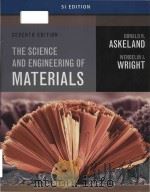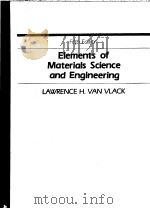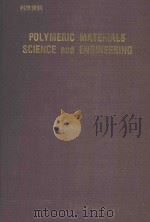《foundations of materials science and engineering P1020》
| 作者 | 编者 |
|---|---|
| 出版 | 未查询到或未知 |
| 参考页数 | |
| 出版时间 | 没有确切时间的资料 目录预览 |
| ISBN号 | 无 — 求助条款 |
| PDF编号 | 820555928(仅供预览,未存储实际文件) |
| 求助格式 | 扫描PDF(若分多册发行,每次仅能受理1册) |

CHAPTER 1Introduction to Materials Scienceand Engineering2
1.1 Materials and Engineering3
1.2 Materials Science and Engineering6
1.3Types of Materials8
1.3.1 Metallic materials8
1.3.2 Polymeric Materials10
1.3.3 Ceramic Materials11
1.3.4 Composite Materials13
1.3.5 Electronic Materials15
1.4 Competition Among Materials16
1.5Recent Advances in Materials Science andTechnology and Future Trends18
1.5.1 Smart Materials18
1.5.2 Nanomaterials19
1.6 Design and Selection20
1.7 Summary21
1.8 Delinitions21
1.9 Problems22
1.10 Materials Selection and DesignProblems23
CHAPTER 2Atomic Structure and Bonding24
2.1 The Structure of Atoms25
2.2Atomic Numbers and Atomic Masses26
2.2.1 Atomic Numbers26
2.2.2 Atomic Masses26
2.3The Electronic Structure of Atoms29
2.3.1 The Hydrogen Atom29
2.3.2 Quantum Numbers of Electrons ofAtoms33
2.3.3 Electronic Structure of MultielectronAtoms35
2.3.4 Electronic Structure and ChemicalReactivity39
2.4Types of Atomic and MolecularBonds41
2.4.1 Primary Atomic Bonds42
2.4.2 Secondarv Atomic and MolecularBonds42
2.5Ionic Bonding42
2.5.1 Ionic Bonding in General42
2.5.2 Interionic Forces for an Ion Pair43
2.5.3 Interionic Energies for an Ion Pair46
2.5.4 Ion Arrangements in Ionic Solids47
2.5.5 Bonding Energies of Ionic Solids48
2.6Covalent Bonding49
2.6.1 Covalent Bonding in the HydrogenMolecule49
2.6.2 Covalent Bonding in Other DiatomicMolecules50
2.6.3 Covalent Bonding by Carbon51
2.6.4 Covalent Bonding in Carbon-ContainingMolecules53
2.6.5 Benzene53
2.7 Metallic Bonding55
2.8Secondary Bonding59
2.8.1 Fluctuating Dipoles60
2.8.2 Permanent Dipoles61
2.9Mixed Bonding62
2.9.1 Ionic-Covalent Mixed Bonding62
2.9.2 Metallic-Covalent Mixed Bonding63
2.9.3 Metallic-Ionic Mixed Bonding64
2.10 Summary64
2.11 Definitions65
2.12 Problems66
2.13 Materials Selection and DesignProblems70
CHAPTER 3Crystal and AmorphousStructure in Materials72
3.1 The Space Lattice and Unit Cells73
3.2 Crystal Systems and BravaisLattices74
3.3Principal Metallic CrystalStructures75
3.3.1 Bodv-Centered Cubic (BCC) CrystalStructure77
3.3.2 Face-Centered Cubic (FCC) CrystalStructure80
3.3.3 Hexagonal Close-Packed (HCP) CrystalStructure81
3.4 Atom Positions in Cubic Unit Cells83
3.5 Directions in Cubic Unit Cells84
3.6 Miller Indices for Crystallographic Planes inCubic Unit Cells88
3.7Crystallographic Planes and Directions inHexagonal Crystal Structure93
3.7.1 Indices for Crystal Planes in HCP UnitCells93
3.7.2 Direction Indices in HCP UnitCells94
3.8Comparison of FCC, HCP, and BCC CrystalStructures96
3.8.1 FCC and HCP Crystal Structures96
3.8.2 BCC Crystal Structuty98
3.9Volume, Planar, and Linear Density Unit-Cell Calculations98
3.9.1 Volume Density98
3.9.2 PlanarAtomic Density99
3.9.3 Linear Atomic Density101
3.10 Polymorphism or Allotropy102
3.11Crystal Structure Analysis103
3.11.1 X-Ray Sources104
3.11.2 X-Ray Diffraction105
3.11.3 X-Ray Diffraction Analysis of CrystalStructures107
3.12 Amorphous Materials113
3.13 Summary114
3.14 Definitions115
3.15 Problems116
3.16 Materials Selection and DesignProblems122
CHAPTER 4Solidification and CrystallineImperfections124
4.1Solidification of Metals125
4.1.1 The Formation of Stable Nuclei in LiquidMetals127
4.1.2 Growth of Crystals in Liquid Metal andFormation of a Grain Structure132
4.1.3 Grain Structure of IndustrialCastings133
4.2 Solidification of Single Crystals134
4.3Metallic Solid Solutions138
4.3.1 Substitutional Solid Solutions139
4.3.2 Interstitial Solid Solutions141
4.4Crystalline Imperfections143
4.4.1 Point Defects143
4.4.2 Line Defects (Dislocations)144
4.4.3 Planar Defects147
4.4.4 Volume Defects150
4.5Experimental Techniques for Identificationof Microstructure and Defects151
4.5.1 Optical Metallography, ASTM Grain Size,and Grain Diameter Determination151
4.5.2 Scanning Electron Microscopy(SEM)156
4.5.3 Transmission Electron Microscopy(TEM)158
4.5.4 High-Resolution Transmission ElectronMicroscopy (HRTEM)159
4.5.5 Scanning Probe Microscopes and AtomicResolution161
4.6 Summary166
4.7 Definitions166
4.8 Problems168
4.9 Materials Selection and DesignProblems170
CHAPTER 5Thermally Activated Processes andDiffusiop in Solids172
5.1 Rate Processes in Solids173
5.2Atomic Diffusion in Solids177
5.2.1 Diffusion in Solids in General177
5.2.2 Diffusion Mechanisms177
5.2.3 Steady-State Diffusion180
5.2.4 Non-Steady-State Diffusion182
5.3Industrial Applications of DiffusionProcesses184
5.3.1 Case Hardening of Steel by Gas Carburizing184
5.3.2 Impurity Diffusion into Silicon Wafers forIntegrated Circuits188
5.4 Effect of Temperature on Diffusion inSolids191
5.5 Summary195
5.6 Definitions195
5.7 Problems196
5.8 Materials Selection and DesignProblems198
CHAPTER 6Mechanical Properties ofMetals Ⅰ200
6.1The Processing of Metals and Alloys201
6.1.1 The Casting of Metals and Alloys201
6.1.2 Hot and Cold Rolling of Metals andAlloys203
6.1.3 Extrusion of Metals and Alloys208
6.1.4 Forging209
6.1.5 Other Metal-Forming Processes211
6.2Stress and Strain in Metals212
6.2.1 Elastic and Plastic Deformation213
6.2.2 Engineering Stress and EngineeringStrain213
6.2.3 Poisson's Ratio216
6.2.4 Shear Stress and Shear Strain216
6.3The Tensile Test and the Engineering Stress-Strain Diagram217
6.3.1 Mechanical Property Data Obtained from the Tensile Test and the EngineeringStress-Strain Diagram220
6.3.2 Comparison of Engineering Stress-StrainCurves for Selected Alloys225
6.3.3 True Stress and True Strain225
6.4 Hardness and Hardness Testing227
6.5Plastic Deformation of Metal SingleCrystals229
6.5.1 Slipbands and Slip Lines on the Surface ofMetal Crystals229
6.5.2 Plastic Deformation in Metal Crystals by the Slip Mechanism232
6.5.3 Slip Systems234
6.5.4 Critical Resolved Shear Stress for MetalSingle Crystals235
6.5.5 Schmid's Law237
6.5.6 Twinning240
6.6Plastic Deformation of PolycrystallineMetals242
6.6.1 Effect of Grain Boundaries on the Strengthof Metals242
6.6.2 Effect of Plastic Deformation onGrain Shape and DislocationArrangements244
6.6.3 Effect of Cold Plastic Deformation onIncreasing the Strength of Metals246
6.7 Solid-Solution Strengthening of Metals247
6.8Recovery and Recrystallization ofPlastically Deformed Metals249
6.8.1 Structure of a Heavily Cold-Worked Metal before Reheating250
6.8.2 Recoverv251
6.8.3 Recrvstallization252
6.9 Superplasticity in Metals257
6.10 Nanocrystalline Metals259
6.11 Summary261
6.12 Definitions262
6.13 Problems263
6.14 Materials Selection and DesignProblems268
CHAPTER 7Mechanical Properties ofMetals Ⅱ270
7.1Fracture of Metals271
7.1.1 Ductile Fracture272
7.1.2 Brittle Fracture273
7.1.3 Toughness and Impact Testing276
7.1.4 Ductile to Brittle TransitionTemperature276
7.1.5 Fracture Toughness279
7.2Fatigue of Metals281
7.2.1 Cyclic Stresses285
7.2.2 Basic Structural Changes that Occur in a Ductile Metal in the FatigueProcess286
7.2.3 Some Major Factors that Affect theFatigue Strength of a Metal287
7.3Fatigue Crack Propagation Rate288
7.3.1 Correlation of Fatigue CrackPropagation with Stress and CrackLength288
7.3.2 Fatigue Crack Growth Rate versus Stress-Intensity Factor Range Plots290
7.3.3 Fatigue Lifee Calculations292
7.4Creep and Stress Rupture of Metals294
7.4.1 Creep of Metals294
7.4.2 The Creep Test296
7.4.3 Creep-Rupture Test297
7.5 Graphical representation of Creep- andStress-Rupture Time-Temperature DataUsing the Larsen-Miller Parameter298
7.6 A Case Study in Failure of MetallicComponents300
7.7Recent Advances and Future Directions inImproving the Mechanical Performance ofMetals303
7.7.1 Improving Ductility and StrengthSimultaneously303
7.7.2 Fatigue Behavior in Nanocrystalline Metals305
7.8 Summary305
7.9 Definitions306
7.10 Problems307
7.11 Materials Selection and DesignProblems309
CHAPTER 8Phase Diagrams310
8.1 Phase Diagrams of Pure Substances311
8.2 Gibbs Phase Rule313
8.3 Cooling Curves314
8.4 Binary Isomorphous Alloy Systems315
8.5 The Lever Rule318
8.6 Nonequilibrium Solidification of Alloys322
8.7 Binary Eutectic Alloy Systems326
8.8 Binary Peritectic Alloy Systems333
8.9 Binary Monotectic Systems338
8.10 Invariant Reactions339
8.11 Phase Diagrams with Intermediate Phasesand Compounds341
8.12 Ternary Phase Diagrams345
8.13 Summary348
8.14 Dernnitions349
8.15 Problems351
8.16 Materials Selection and DesignProblems355
CHAPTER 9Engineering Alloys358
9.1Production of Iron and Steel360
9.1.1 Production of Pig Iron in a BlastFurnace360
9.1.2 Steelmaking and Processing of Major SteelProduct Forms361
9.2The Iron-Iron-Carbide System363
9.2.1 The Iron-Iron-Carbide PhaseDiagram363
9.2.2 Solid Phases in the Fe-Fe3C PhaseDiagram363
9.2.3 Invariant Reactions in the Fe-Fe3C PhaseDiagram364
9.2.4 Slow Cooling of Plain-Carbon Steels366
9.3Heat Treatment of Plain-CarbonSteels373
9.3.1 Martensite373
9.3.2 Isothermal Decomposition ofAustenite378
9.3.3 Continuous-Cooling TransformationDiagram for a Eutectoid Plain-CarbonSteel383
9.3.4 Annealing and Normalizing of Plain-Carbon Steels386
9.3.5 Tempering of Plain-Carbon Steels387
9.3.6 Classification of Plain-Carbon Steels andTypical Mechanical Properties391
9.4Low-Alloy Steels392
9.4.1 Classification of Alloy Steels392
9.4.2 Distribution of Alloying Elements in AlloySteels394
9.4.3 Effects of Alloying Elements on theEutectoid Temperature of Steels395
9.4.4 Hardenability396
9.4.5 Typical Mechanical Properties andApplications for Low-Alloy Steels401
9.5Aluminum Alloys401
9.5.1 Precipitation Strengthening(Hardening)403
9.5.2 General Properties of Aluminum and ItsProduction410
9.5.3 Wrought Aluminum Alloys411
9.5.4 Aluminum Casting Alloys416
9.6Copper Alloys418
9.6.1 General Properties of Copper418
9.6.2 Production of Copper419
9.6.3 Classification of Copper Alloys419
9.6.4 Wrought Copper Alloys422
9.7Stainless Steels424
9.7.1 Ferritic Stainless Steels424
9.7.2 Martensitic Stainless Steels425
9.7.3 Austenitic Stainless Steels427
9.8Cast Irons429
9.8.1 General Properties429
9.8.2 Types of Cast Irons429
9.8.3 White Cast Iron429
9.8.4 Gray Cast Iron431
9.8.5 Ductile Cast Irons432
9.8.6 Malleable Cast Irons435
9.9Magnesium, Titanium, and NickelAlloys436
9.9.1 Magnesium Alloys436
9.9.2 Titanium Alloys438
9.9.3 Nickel Alloys440
9.10Special-Purpose Alloys andApplications441
9.10.1 Intermetallics441
9.10.2 Shape-Memory Alloys442
9.10.3 Amorphous Metals446
9.11Metals in Biomedical Applications—Biometals448
9.11.1 Stainless Steels449
9.11.2 Cobalt-Based Alloys449
9.11.3 Titanium Alloys451
9.12 Some Issues in the Orthopedic Application of Metals452
9.13 Summary454
9.14 Definitions455
9.15 Problems457
9.16 Materials Selection and DesignProblems465
CHAPTER 10Polymeric Materials468
10.1 Introduction469
10.2Polymerization Reactions471
10.2.1 Covalent Bonding Structure of anEthylene Molecule471
10.2.2 Covalent Bonding Structure of an Activated Ethylene Molecule472
10.2.3 General Reaction for the Polymerization of Polyethylene and the Degree ofPolvmerization473
10.2.4 Chain Polymerization Steps473
10.2.5 Average Molecular Weight forThermoplastics475
10.2.6 Functionality of a Monomer476
10.2.7 Structure of Noncrystalline LinearPolymers476
10.2.8 Vinyl and Vinylidene Polymers478
10.2.9 Homopolymers and Copolymers479
10.2.10 Other Methods of Polymerization482
10.3 Industrial Polymerization Methods484
10.4Crystallinity and Stereoisomerism in SomeThermoplastics486
10.4.1 Solidification of NoncrystallineThermoplastics486
10.4.2 Solidification of Partly CrystallineThermoplastics486
10.4.3 Structure of Partly CrystallineThermoplastic Materials488
10.4.4 Stereoisomerism in Thermoplastics489
10.4.5 Ziegler and Natta Catalysts490
10.5Processing of Plastic Materials491
10.5.1 Processes Used for ThermoplasticMaterials492
10.5.2 Processes Used for ThermosettingMaterials496
10.6General-Purpose Thermoplastics498
10.6.1 Polyethylene500
10.6.2 Polyvinyl Chloride and Copolymers503
10.6.3 Polypropylene505
10.6.4 Polvstvrene505
10.6.5 Polvacrvlonitrile506
10.6.6 Styrene-Acrylonitrile (SAN)507
10.6.7 ABS507
10.6.8 Polymethyl Methacrylate (PMMA)509
10.6.9 Fluoroplastics510
10.7Engineering Thermoplastics511
10.7.1 Polyamides (Nylons)512
10.7.2 Polycarbonate515
10.7.3 Phenylene Oxide-Based Resins516
10.7.4 Acetals517
10.7.5 Thermoplastic Polyesters518
10.7.6 Polyphenylene Sulfide519
10.7.7 Polvetherimide520
10.7.8 PolvmerAllovs521
10.8Thermosetting Plastics (Thermosets)521
10.8.1 Phenolics523
10.8.2 Epoxy Resins525
10.8.3 Unsaturated Polyesters527
10.8.4 Amino Resins (Ureas andMelamines)529
10.9Elastomers (Rubbers)531
10.9.1 Natural Rubber531
10.9.2 Synthetic Rubbers534
10.9.3 Properties of PolychloropreneElastomers536
10.9.4 Vulcanization of PolychloropreneElastomers536
10.10Deformation and Strengthening of PlasticMaterials539
10.10.1 Deformation Mechanisms forThermoplastics539
10.10.2 Strengthening of Thermoplastics541
10.10.3 Strengthening of ThermosettingPlastics545
10.10.4 Effect of Temperature on the Strength ofPlastic Materials545
10.11Creep and Fracture of PolymericMaterials546
10.11.1 Creep of Polymeric Materials546
10.11.2 Stress Relaxation of PolymericMaterials547
10.11.3 Fracture of PolymericMaterials550
10.12Polymers in Biomedical Applications—Biopolymers552
10.12.1 Cardiovascular Applications ofPolymers553
10.12.2 Ophthalmic Applications554
10.12.3 Drug-Delivery Systems555
10.12.4 Suture Materials556
10.12.5 Orthopedic Applications556
10.13 Summary557
10.14 Definitions558
10.15 Problems560
10.16 Materials Selection and DesignProblems570
CHAPTER 11Ceramics572
11.1 Introduction573
11.2Simple Ceramic CrystalStructures575
11.2.1 Ionic and Covalent Bonding in SimpleCeramic Compounds575
11.2.2 Simple Ionic Arrangements Found inlonically Bonded Solids576
11.2.3 Cesium Chloride (CsCl) CrystalStructure579
11.2.4 Sodium Chloride (NaCl) CrystalStructure580
11.2.5 Interstitial Sites in FCC and HCP CrystalLattices584
11.2.6 Zinc Blende (ZnS) CrystalStructure586
11.2.7 Calcium Fluoride (CaF2) CrystalStructure588
11.2.8 Antifluorite Crystal Structure590
11.2.9 Corundum (Al2O3) CrystalStructure590
11.2.10 Spinel (MgAl204) Crystal Structure590
11.2.11 Perovskite (CaTiO3) Crystal Structure590
11.2.12 Carbon and Its Allotropes591
11.3Silicate Structures595
11.3.1 Basic Structural Unit of the SilicateStructures595
11.3.2 Island, Chain, and Ring Structures ofSilicates595
11.3.3 Sheet Structures of Silicates595
11.3.4 Silicate Networks597
11.4Processing of Ceramics598
11.4.1 Materials Preparation599
11.4.2 Forming599
11.4.3 Thermal Treatments604
11.5Traditional and EngineeringCeramics606
11.5.1 Traditional Ceramics606
11.5.2 Engineering Ceramics609
11.6Mechanical Properties of Ceramics611
11.6.1 General611
11.6.2 Mechanisms for the Deformation of Ceramic Materials611
11.6.3 Factors Affecting the Strength of CeramicMaterials612
11.6.4 Toughness of Ceramic Materials613
11.6.5 Transformation Toughening of PartiallyStabilized Zirconia (PSZ)615
11.6.6 Fatigue Failure of Ceramics615
11.6.7 Ceramic Abrasive Materials617
11.7Thermal Properties of Ceramics618
11.7.1 Ceramic Refractory Materials619
11.7.2 Acidic Refractories620
11.7.3 Basic Refractories620
11.7.4 Ceramic Tile Insulation for the SpaceShuttle Orbiter620
11.8Glasses620
11.8.1 Definition of a Glass622
11.8.2 Glass Transition Temperature622
11.8.3 Structure of Glasses623
11.8.4 Composition of Glasses624
11.8.5 Viscous Deformation of Glasses626
11.8.6 Forming Methods for Glasses628
11.8.7 Tempered Glass630
11.8.8 Chemically Strengthened Glass630
11.9Ceramic Coatings and SurfaceEngineering632
11.9.1 Silicate Glasses632
11.9.2 Oxides and Carbides632
11.10Ceramics in Biomedical Applications634
11.10.1 Alumina in OrthopedicImplants634
11.10.2 Alumina in Dental Implants636
11.10.3 Ceramic Implants and TissueConnectivity636
11.11 Nanotechnology and Ceramics637
11.12 Summary639
11.13 Definitions640
11.14 Problems642
11.15 Materials Selection and DesignProblems646
CHAPTER 12Composite Materials648
12.1 Introduction649
12.2Fibers for Reinforced-Plastic CompositeMaterials651
12.2.1 Glass Fibers for Reinforcing PlasticResins651
12.2.2 Carbon Fibers for ReinforcedPlastics653
12.2.3 Aramid Fibers for Reinforcing PlasticResins654
12.2.4 Comparison of Mechanical Propertiesof Carbon, Aramid, and Glass Fibersfor Reinforced-Plastic CompositeMaterials655
12.3Fiber-Reinforced-Plastic CompositeMaterials657
12.3.1 Matrix Materials for Fiber-ReinforcedPlastic Composite Materials657
12.3.2 Fiber-Reinforced-Plastic CompositeMaterials658
12.3.3 Equations for Elastic Modulus of aLamellar Continuous-Fiber-PlasticMatrix Composite for Isostrain andIsostress Conditions662
12.4Open-Mold Processes for Fiber-Reinforced-Plastic Composite Materials667
12.4.1 Hand Lay-Up Process667
12.4.2 Spray-Up Process667
12.4.3 Vacuum Bag-Autoclave Process668
12.4.4 Filament-Winding Process670
12.5Closed-Mold Processes for Fiber-ReinforcedPlastic Composite Materials672
12.5.1 Compression and Injection Molding672
12.5.2 The Sheet-Molding Compound (SMC)Process672
12.5.3 Continuous-Prorusion Process674
12.6Concrete674
12.6.1 Portland Cement675
12.6.2 Mixing Water for Concrete678
12.6.3 Aggregates for Concrete679
12.6.4 Air Entrainment679
12.6.5 Compressive Strength of Concrete679
12.6.6 Proportioning of Concrete Mixtures679
12.6.7 Reinfoorced and Prestressed Concrete682
12.6.8 Prestressed Concrete683
12.7Sandwich Structures684
12.7.1 Honeycomb Sandwich Structure684
12.7.2 Cladded Metal Structures685
12.8Metal-Matrix and Ceramic-MatrixComposites685
12.8.1 Metal-Matrix Composites (MMCs)685
12.8.2 Ceramic-Matrix Composites(CMCs)689
12.8.3 Ceramic Composites andNanotechnology692
12.9Bone: A Natural Composite Material692
12.9.1 Composition692
12.9.2 Macrostructure692
12.9.3 Mechanical Properties694
12.9.4 Biomechanics of Bone Fracture695
12.9.5 Viscoelasticity of the Bone696
12.9.6 Bone Remodeling696
12.9.7 Nanotechnology and Bone Repair697
12.10 Summary697
12.11 Definitions698
12.12 Problems700
12.13 Materials Selection and DesignProblems704
CHAPTER 13Corrosion706
13.1 General707
13.2Electrochemical Corrosion of Metals708
13.2.1 Oxidation-Reduction Reactions708
13.2.2 Standard Electde Half-Cell Potentialsfor Metals710
13.3Galvanic Cells712
13.3.1 Macroscopic Galvanic Cells withElectrolytes That Are One Molar712
13.3.2 Galvanic Cells with Electrolytes That AreNot One Molar714
13.3.3 Galvanic Cells with Acid or Alkalinefor Metals Electrolytes with No Metal IonsPresent715
13.3.4 Microscopic Galvanic Cell Corrosion ofSingle Electrodes717
13.3.5 Concentration Galvanic Cells718
13.3.6 Galvanic Cells Created by Differences inComposition, Structure, and Stress721
13.4Corrosion Rates (Kinetics)723
13.4.1 Rate of Uniform Corrosion orElectroplating of a Metal in an AqueousSolution724
13.4.2 Corrosion Reactions and Polarization727
13.4.3 Passivation730
13.4.4 The Galvanic Series731
13.5Types of Corrosion733
13.5.1 Uniform or General Attack Corrosion733
13.5.2 Galvanic or Two-Metal Corrosion733
13.5.3 Pitting Corrosion734
13.5.4 Crevice Corrosion737
13.5.5 lntergranular Corrosion739
13.5.6 Stress Corrosion741
13.5.7 Erosion Corrosion744
13.5.8 Cavitation Damage744
13.5.9 Fretting Corrosion745
13.5.10 Selective Leaching745
13.5.11 Hydrogen Damage746
13.6Oxidation of Metals747
13.6.1 Protective Oxide Films747
13.6.2 Mechanisms of Oxidation749
13.6.3 Oxidation Rates (Kinetics)750
13.7Corrosion Control752
13.7.1 Materials Selection752
13.7.2 Coatings753
13.7.3 Design754
13.7.4 Alteration of Environment755
13.7.5 Cathodic and Anodic Protection756
13.8 Summary758
13.9 Definitions758
13.10 Problems759
13.11 Materials Selection and DesignProblems764
CHAPTER14 Electrical Properties of Materials766
14.1Electrical Conduction in Metals767
14.1.1 The Classical Model for ElectricalConduction in Metals767
14.1.2 Ohm's Law769
14.1.3 Drift Velocity of Electrons in al Conducting Metal773
14.1.4 Electrical Resistivity of Metals774
14.2Energy-Band Model for ElectricalConduction778
14.2.1 Energy-Band Model for Metals778
14.2.2 Energy-Band Model for Insulators780
14.3Intrinsic Semiconductors780
14.3.1 The Mechanism of Electrical Conduction in Intrinsic Semiconductors780
14.3.2 Electrical Charge Transport in theCrystal Lattice of Pure Silicon781
14.3.3 Energy-Band Diagram for IntrinsicElemental Semiconductors782
14.3.4 Quantitative Relationships for ElectricalConduction in Elemental IntrinsicSemiconductors783
14.3.5 Effect of Temperature on IntrinsicSemiconductivity785
14.4Extrinsic Semiconductors787
14.4.1 n-Type (Negative-Type) ExtrinsicSemiconductors787
14.4.2 p-Type (Positive-Type) ExtrinsicSemiconductors789
14.4.3 Doping of Extrinsic SiliconSemiconductor Material791
14.4.4 Effect of Doping on CarrierConcentrations in ExtrinsicSemiconductors791
14.4.5 Effect of Total Ionized ImpurityConcentration on the Mobility ofCharge Carriers in Silicon at RoomTemperature794
14.4.6 Effect of Temperature on the ElectricalConductivity of ExtrinsicSemiconductors795
14.5Semiconductor Devices797
14.5.1 The pn Junction798
14.5.2 Some Application for pn JunctionDiodes801
14.5.3 The Bipolar Junction Transistor803
14.6Microelectronics804
14.6.1 Microelectronic Planar BipolarTransistors806
14.6.2 Microelectronic Planar Field-EffectTransistors807
14.6.3 Fabrication of MicroelectronicIntegrated Circuits809
14.7 Compound Semiconductors816
14.8Electrical Properties of Ceramics819
14.8.1 Basic Properties of Dielectrics819
14.8.2 Ceramic Insulator Materials822
14.8.3 Ceramic Materials far Capacitors823
14.8.4 Ceramic Semiconductors824
14.8.5 Ferroelectric Ceramics826
14.9 Nanoelectronics829
14.10 Summary830
14.11 Definitions831
14.12 Problems834
14.13 Materials Selection and DesignProblems838
CHAPTER 15Optical Properties andSuperconductive Materials840
15.1 Introduction841
15.2 Light and the ElectromagneticSpectrum841
15.3Refraction of Light844
15.3.1 Index of refraction844
15.3.2 Snell's Law of Light Refraction845
15.4Absorption, Transmission, and Reflection ofLight847
15.4.1 Metals847
15.4.2 Silicate Glasses847
15.4.3 Plastics850
15.4.4 Semiconductors850
15.5Luminescence851
15.5.1 Photoluminescence852
15.5.2 Cathodoluminescence852
15.6Stimulated Emission of Radiation andLasers854
15.6.1 Types of Lasers856
15.7Optical Fibers858
15.7.1 Light Loss in Optical Fibers858
15.7.2 Single-Mode and Multimode OpticalFibers859
15.7.3 Fabrication of Optical Fibers860
15.7.4 Modern Optical-Fiber CommunicationSystems862
15.8Superconducting Materials863
15.8.1 The Superconducting State863
15.8.2 Magnetic Properties ofSuperconductors864
15.8.3 Current Flow and Magnetic Fields inSuperconductors866
15.8.4 High-Current, High-FieldSuperconductors867
15.8.5 High Critical Temperature (Tc)Superconducting Oxides869
15.9 Definitions871
15.10 Problems872
15.11 Materials Selection and DesignProblems874
CHAPTER 16Magnetic Properties888
16.1 Introduction889
16.2Magnetic Fields and Quantities889
16.2.1 Magnetic Fields889
16.2.2 Magnetic Induction892
16.2.3 Magnetic Permeability892
16.2.4 Magnetic Susceptibility894
16.3Types of Magnetism882
16.3.1 Diamagnetism883
16.3.2 Paramagnetism883
16.3.3 Ferromagnetism883
16.3.4 Magnetic Moment of a Single UnpairedAtomic Electron885
16.3.5 Antiferromagnetism887
16.3.6 Ferrimagnetism887
16.4 Effect of Temperature onFerromagnetism887
16.5 Ferromagnetic Domains888
16.6Types of Energies That Determine theStructure of FerromagneticDomains890
16.6.1 Exchange Energy890
16.6.2 Magnetostatic Energy891
16.6.3 Magnetocrystalline AnisotropyEnergy891
16.6.4 Domain Wall Energy892
16.6.5 Magnetostrictive Energy893
16.7 The Magnetization and Demagnetization ofa Ferromagnetic Metal895
16.8Soft Magnetic Materials896
16.8.1 Desirable Properties for Soft MagneticMaterials897
16.8.2 Energy Losses for Soft MagneticMaterials897
16.8.3 Iron-Silicon Alloys898
16.8.4 Metallic Glasses899
16.8.5 Nickel-Iron Alloys900
16.9Hard Magnetic Materials903
16.9.1 Properties of Hard MagneticMaterials903
16.9.2 Alnico Alloys905
16.9.3 Rare earth Alloys907
16.9.4 Neodymium-Iron-Boron MagneticAlloys909
16.9.5 Iron-Chromium-Cobalt MagneticAlloys909
16.10Ferrites911
16.10.1 Magnetically Soft Ferrites923
16.10.2 Magnetically Hard Ferrites928
16.11 Summary916
16.12 Definitions917
16.13 Problems920
16.14 Materials Selection and DesignProblems924
APPENDIX Ⅰ Important Properties ofSelected Engineering Materials925
APPENDIX Ⅱ Some Properties ofSelected Elements980
APPENDIX Ⅲ Ionic Radii of the Elements982
APPENDIX Ⅳ Selected Physical Quantitiesand Their Units985
References for Further Study byChapter987
Glossary990
Answers1001
ndex1004
《foundations of materials science and engineering P1020》由于是年代较久的资料都绝版了,几乎不可能购买到实物。如果大家为了学习确实需要,可向博主求助其电子版PDF文件。对合法合规的求助,我会当即受理并将下载地址发送给你。
高度相关资料
-
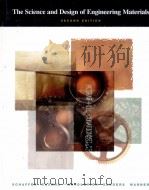
- THE SCIENCE AND DESIGN OF ENGINEERING MATERIALS SECOND EDITION
- 1999 MCGRAW-HILL INC.
-

- ELEMENTS OF MATERIALS SCIENCE AND ENGINEERING
- 1980 ADDISON-WELSEY PUBLISHING CO.
-

- SCIENCE OF ENGINEERING MATERIALS
- 1987 COPYRIGHT
-
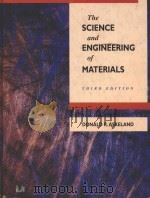
- THE SCIENCE AND ENGINEERING OF MATERIALS THIRD EDITION
- 1994 PWS PUBLISHING COMPANY
-

- Engineering materials science
- 1995 Academic Press
-

- Encyclopedia of materials science and engineering volume 8 indexes
- 1986 Pergamon Press
-

- ENCYCLOPEDIA OF MATERIALS SCIENCE AND ENGINEERING SUPPLEMENTARY VOLUME 1
- 1988 PERGAMON PRESS AND THE MIT PRESS
-
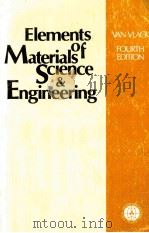
- ELEMENTS OF MATERIALS SCIENCE AND ENGINEERING FOURTH EDITION
- 1980 ADDISON-WESLEY PUBLISHING COMPANY
-
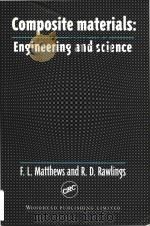
- Composite materials engineering and science
- 1999 Woodhead Pub.
-
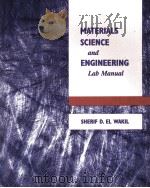
- MATERIALS SCIENCE AND ENGINEERING LAB MANUAL
- 1994 PWS PUBLISHING COMPANY
提示:百度云已更名为百度网盘(百度盘),天翼云盘、微盘下载地址……暂未提供。➥ PDF文字可复制化或转WORD


